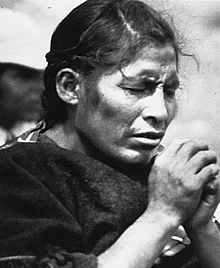Aymara (people)

The Aymara (also Aimara ) are an indigenous people of South America . They live in the Andes region on the Altiplano in Bolivia (about 30-40% of the population) in southern Peru (about 5% of the population) and (in smaller numbers, about 0.3% of the population) in northern Chile . Sometimes the name Colla is used for them (inaccurately), which goes back to a previous indigenous population. There is also an extremely low distribution in Ecuador - Spanish forced resettlements in the colonial era are responsible for this, the purpose of which was to prevent a “we-feeling” among the indigenous peoples, from which resistance against the colonial rulers could have developed.
origin
There are various theses about the origin of the Aymara people.
The Aymara are regarded as one of the oldest surviving peoples of the high Andes, and are based on current knowledge, the descendants of the (long before the Inca existing) Tiwanaku - high culture (.... 1580 BC to 1172 AD). The former imperial territory roughly coincides with today's Aymara language area. The capital of the Tiwanaku empire, located at 3600 m, probably had over 40,000 inhabitants in the 12th century; this culture is considered to be one of the first societies in South America to build with stone. Although archaeologists have only uncovered a sixth of this site, it is already considered to be the most important sight in South America.
Linguists, who suspect the origin of the Aymara in northern parts of the Andes, especially in Peru, contradict this. The dialects there gradually expanded south into the Bolivian Altiplano and were later heavily influenced by the Inca in particular.
Culture
Culturally, the Aymara share a lot with other peoples of the Andes, for example the Quechua-speaking ethnic groups . This also applies to the Andean religion, many elements of which have survived to this day, although nominally almost all of the Aymara are Catholics . This led to a merging of indigenous and Christian ideas ( syncretism ). To this day, the Aymara, for example, venerate mother earth ( Pachamama ) and father sun ( Willkatata ) and make sacrifices to them.
Their language, Aymara , is one of the official languages in Bolivia and Peru .
Exploitation and discrimination
At the time of the Inca and especially during the colonial period , the Aymara were forcibly resettled within the Andean region. Even after the independence of Bolivia and Peru, the Aymara had no rights and were subject to exploitation and discrimination . The spread of the hacienda system also drove them out to large areas. In addition, they were deprived of their material livelihood through the privatization of the collective lands. As a result, many Aymara had to do forced labor on the estates of the large landowners.
Known Aymara
- David Choquehuanca Céspedes (* 1961), Bolivian politician, Foreign Minister (2006-2017), Vice-presidential candidate of the Movement for Socialism (2020)
- Juan Evo Morales Ayma (* 1959), President of Bolivia (2006-2019), chairman of the Movement for Socialism, comes from an Aymara family in Orinoca (Urinuqa)
- Felipe Quispe Huanca (* 1942), leader of the Movimiento Indígena Pachakuti , a Bolivian party mainly supported by Aymara
literature
German
- Juliana Ströbele-Gregor: Dialectic of the Counter-Enlightenment. On the problem of fundamentalist and evangelical proselytizing among the urban Aymara in La Paz (Bolivia). Holos Verlag, Bonn 1988.
- Angela Meentzen: Femininity, Power and Gender Relations in Change. The social order of the rural Aymara of Peru from a female perspective. (= Berlin Latin America Research. 11). Vervuert, Frankfurt am Main 2000, ISBN 3-89354-161-6 .
- Raimund Schramm: Symbolic logic in the oral tradition of the Aymaras. Dietrich Reimer Verlag, Berlin 1988, ISBN 3-496-00984-5 .
- Iván Tavel: Religion and Politics in the Aymara Ethnicity. tuduv, Munich 1989.
- Moema Viezzer: "If I am allowed to speak ...": The testimony of Domitila, a woman from the mines of Bolivia. 4th edition. Lamuv, Göttingen 1990, ISBN 3-921521-56-4 .
English
- Laurie Adelson, Arthur Tracht: Aymara Weavings: Ceremonial Textiles of Colonial and 19th Century Bolivia. Smithsonian Institution Traveling Exhibition Service, Washington, DC 1983, ISBN 0-86528-022-3 .
- Hans C. Buechler: The Masked Media: Aymara Fiestas and Social Interaction in the Bolivian Highlands . (= Approaches to semiotics. 59). Mouton, The Hague 1980, ISBN 90-279-7777-1 .
- Hans C. Buechler, Judith-Maria Buechler: The Bolivian Aymara. (= Case studies in cultural anthropology ). Holt, Rinehart and Winston, New York 1971, ISBN 0-03-081380-8 .
- William E. Carter: Aymara Communities and the Bolivian Agrarian Reform. University of Florida Press, Gainesville 1964.
- James Eagen: The Aymara of South America. Lerner Publications Co, First peoples, Minneapolis 2002, ISBN 0-8225-4174-2 .
- Alan L. Kolata : Valley of the Spirits: A Journey into the Lost Realm of the Aymara . Wiley, New York 1996, ISBN 0-471-57507-0 .
- Ted C. Lewellen: Peasants in Transition: The Changing Economy of the Peruvian Aymara: a General Systems Approach. Westview Press, Boulder, Colo 1978, ISBN 0-89158-076-X .
- Andrew Orta: Catechizing Culture: Missionaries, Aymara, and the "New Evangelism". Columbia University Press, New York 2004, ISBN 0-231-13068-6 .
- Silvia Rivera Cusicanqui : Oppressed but Not Defeated: Peasant Struggles Among the Aymara and Qhechwa in Bolivia, 1900-1980 . United Nations Research Institute for Social Development, Geneva 1987.
- Harry Tschopik: The Aymara of Chucuito, Peru . 1951.
Web links
- Literature about the Aymara in the catalog of the Iberoamerican Institute in Berlin.
- www.wissenschaft.de: Back to the future - With the Aymara, the future is behind and the past is ahead; they have a completely different concept of time than all cultures on earth that have been studied so far.
Individual evidence
- ^ Society for Threatened Peoples : Aymara. , accessed on August 1, 2020.
- ^ Society for Threatened Peoples : Aymara. , accessed on August 5, 2020.
